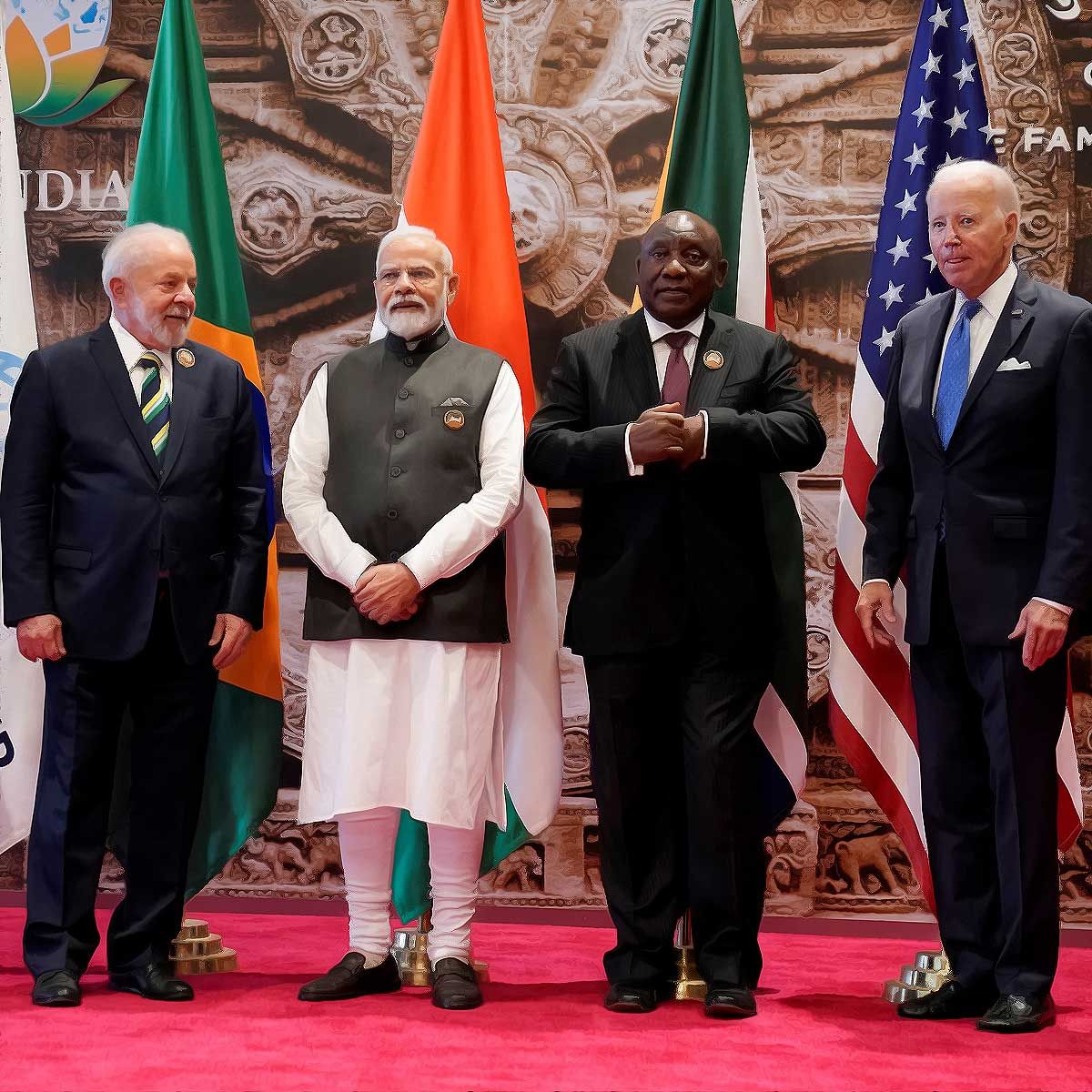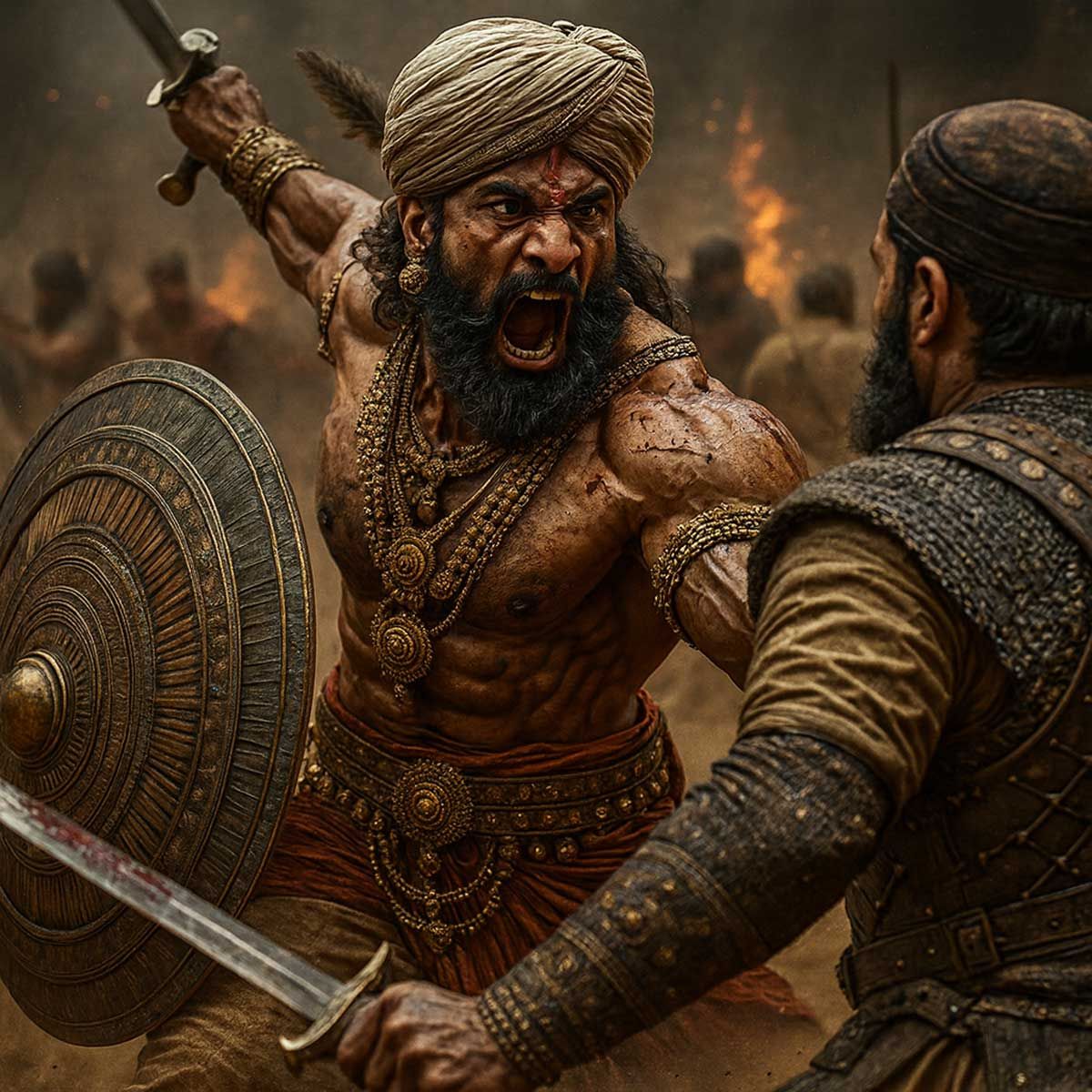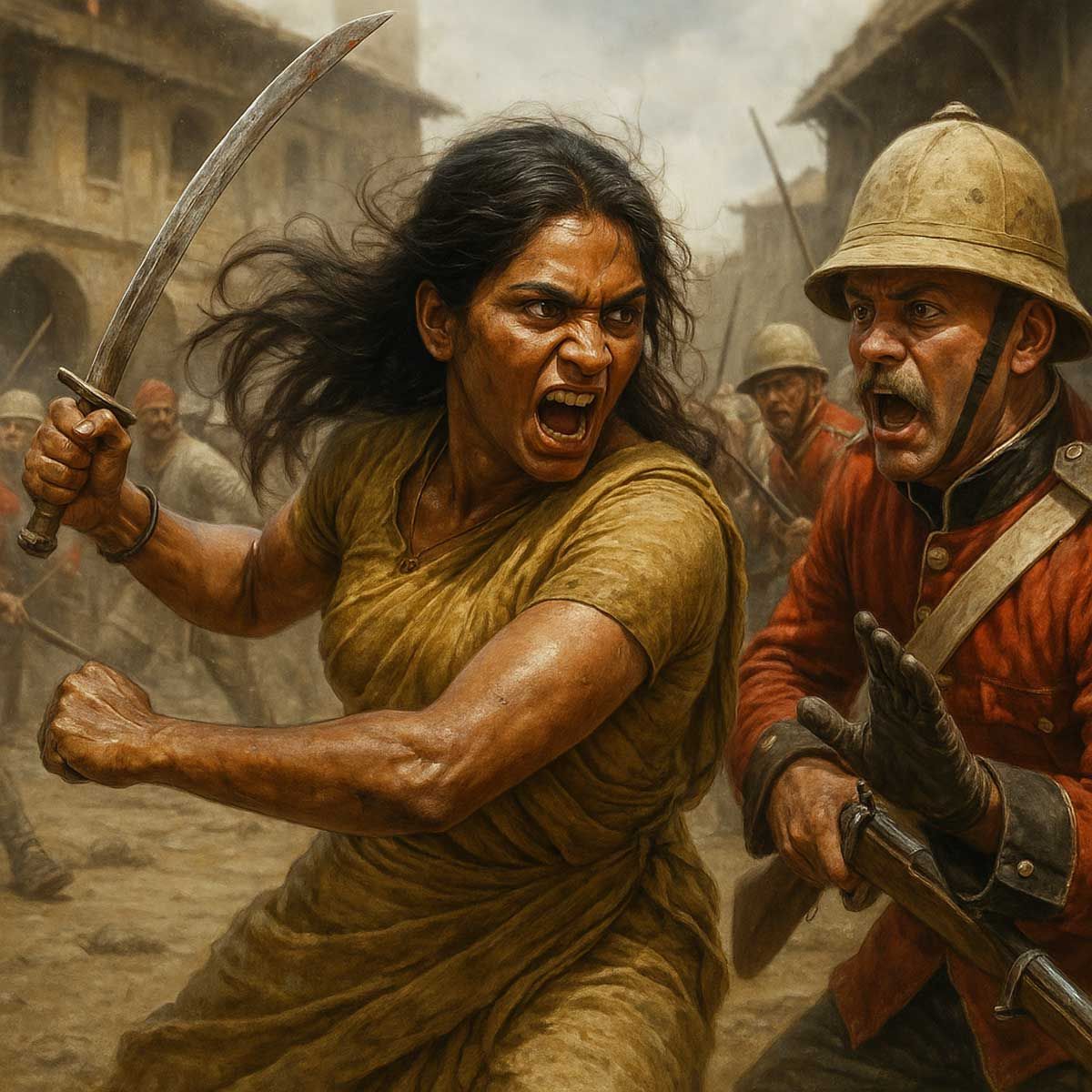More Coverage
Twitter Coverage
Satyaagrah
Written on
Satyaagrah
Written on
Satyaagrah
Written on
Satyaagrah
Written on
Satyaagrah
Written on
Join Satyaagrah Social Media
G20 Summit at Bharat Mandapam unveils India's profound legacy through Panini's 'Ashtadhyayi', the majestic Konark Wheel, ancient arts and more, a riveting testament to India's rich history, a beacon of cultural synergy and global unity in modern times

In a spectacular display of India's rich and vibrant historical lineage, the Bharat Mandapam became the nucleus of cultural convergence during the much-anticipated G20 Summit. This monumental event saw the unveiling of significant artifacts that narrate the timeless tale of India's grand civilization, a story encapsulated within the intricate details of the celebrated "Ashtadhyayi" by Panini, the age-old wisdom woven in the verses of the Rig Veda, and the majestic images depicting the prehistoric Bhimbhetka cave paintings in Madhya Pradesh, a breathtaking journey back to almost 30,000 years in time.
|
In an era that constantly thrives on progression, the event held on the 9th and 10th of September transported leaders from across the globe back to the rich roots of Indian heritage at the heart of New Delhi, a pulsating metropolis that graciously embraced the blend of past and present. Amidst discussions of forging a forward-focused world, the leaders were given a glimpse into the historical narrative that India proudly carries in its essence.
With a resounding theme echoing the philosophy of "Vasudhaiva Kutumbakam", the revered belief that the world is one family, the Ministry of Culture took a monumental leap in bringing to fruition the 'Culture Corridor- G20 Digital Museum'. This international project, launched fervently on the first day of the summit, stood as a testament to the universal bond that intertwines the rich histories and cultures of the G20 members and invitee nations.
An official statement reverberated the sentiments of unity and shared heritage, emphasizing that the “Culture Corridor” was an emblem of the synergies that exist between different nations, binding them in a thread of mutual respect and appreciation. This campaign, dubbed 'Culture Unites All', was the hallmark initiative of the Culture Working Group (CWG), seeking to forge bonds that transcend borders.
|
The Bharat Mandapam became a living canvas that portrayed the majestic narratives of cultures in convergence. It was here that visitors witnessed a magnificent display of art objects that held the essence of numerous countries, brilliantly showcased in a harmonious blend of physical and digital realms. This temporary 'art corridor' was more than a mere exhibition; it was a vivid illustration of global unity, a vibrant tapestry woven with threads of diverse cultures coming together for a historic event.
At the centre of it all stood the grand Bharat Mandapam, a beacon of India's glorious past, holding within its confines splendid representations of cultural magnificence, including a towering statue of Natraj - a divine depiction of cosmic dances, the serene Shhank or Conch Shell which resonates with spiritual fervor, the Surya Dwar - a homage to the sun, and the Pragati Chakra or the Wheel of Prosperity, embodying the hopes and dreams of a thriving nation.
Every artifact, every element showcased was not just a piece of art, but a fragment of India's soul, an invitation to delve deeper into the heart of a nation that holds tales of grandeur, resilience, and an everlasting spirit of unity in diversity. This grand occasion was a reminder, a reverberating echo that the world, in all its diversity, is but one family, united in a dance of cultural harmony and mutual appreciation.
|
In an exhilarating celebration of unity and cultural diversity, the Bharat Mandapam vividly portrayed the universal theme, "Culture Unites All", coming to life with unparalleled splendor. Akin to a pulsating heartbeat of India, the Mandapam embraced and showcased the multifaceted gems of Indian states in a grandiose canvas that left an indelible mark on the hearts of attendees.
Imagine stepping into a realm where the brilliance of Indian craftsmanship shone in full glory: the gleaming Silver filigree artefacts that narrate the skilled artistry of Telangana, the vibrant tapestry of colourful jewellery that echoed the spirit of Nagaland, and the sheer splendour of Eri – the Millennia-old silk from Assam, creating a crafts bazaar that resounded with the echoes of a diverse and rich heritage that India embodies. This was not just a bazaar, but a festive congregation that celebrated the rich tapestry of Indian culture with fervent pride and joy.
Yet, this grand celebration transcended beyond the boundaries of India, offering a heartwarming homage to the cherished democratic values that have been deeply rooted in Bhartiya civilization and echoed across the globe. It was a sight to behold as vital artifacts stood as sentinels of these democratic values, holding within them the spirit of unity and the universal brotherhood. Among them were the profound teachings within the Rig Veda Manuscripts, a revered copy of the Declaration of the Rights of Man and of the Citizen National Assembly from France, a symbolic copy of the charters of freedom from the USA, and a historic poster depicting the first democratic general election of the Republic of Korea. These were not just artifacts, but living testimonies to the democratic essence that binds nations together in a global fraternity.
|
In a grand gesture of international camaraderie, the special museum extended its embrace to honor the distinct cultural heritages of other G20 nations and invitee countries. It was here that the global community witnessed an eclectic display of the world's wonders - the intricate Batik Sarong Textiles from Indonesia that tell tales of ancient craftsmanship, a miniature yet imposing model of Brazil's National Parliament that stood as a symbol of democratic spirit, the traditional Poncho from Argentina that embodied the vibrant culture of the land, and an exquisite replica of the iconic Volkswagen Old Beetle from Germany, a testament to innovation and engineering excellence.
The audience also marveled at the presence of Italy's contribution, a bronze statue of Apollo Belvedere, which stood as a beacon of artistry and classical elegance. Further adding a touch of contemporary artistry was Japan's Nendoroid Hastune Miku, a vibrant representation of modern culture amalgamated with traditional nuances. These international contributions intertwined gracefully with India's high civilizational legacy, a vivid representation of which was clearly reflected through the grand showcase of Panini's 'Ashtadhyayi' and the Rig Veda inscriptions, alongside the entrancing digital images of the Bhimbhetka cave paintings in Madhya Pradesh, a portal that takes one 30,000 years back, narrating tales of an ancient civilization steeped in art and culture.
Thus, the Bharat Mandapam became a global stage where the past met the present, where cultures intertwined, and where the world united to celebrate a legacy of diversity and unity, standing together as one, bound by the shared love for art, culture, and the undying spirit of unity in diversity. It was a celebration that echoed the proud and high civilizational legacy of India, a nation that embodies the spirit of "Vasudhaiva Kutumbakam" - The World is One Family.
|
Panini’s Ashtadhyayi
In the electrifying ambiance of the Bharat Mandapam, one could not ignore the profound echo of the illustrious past that resonated with the vibrancy and intellectual prowess that India has fostered for millennia. Central to this grand celebration was the awe-inspiring showcase of Panini's Ashtadhyayi, a masterwork that stands as a testament to the country's ancient scholarship and intellectual grandeur.
Picture this: a sacred document composed in the 5th-6th century BCE, meticulously crafted by the revered scholar Panini, unfolding over eight chapters and housing an expansive treasure of 4000 sutras. This isn't just a manuscript, but a fascinating journey through the realms of Vedic phonetics and grammar, a testament to India's golden era of knowledge and wisdom. The depth of this treatise has often been paralleled to the complexities of the modern Turing machine, a beacon of mathematical and computational excellence, embodying the essence of any computational device to its core.
|
|
Envisage the genius of Panini, a luminary who ventured far beyond his time, crafting a linguistic masterpiece that seemingly anticipated the intricacies of modern computer programs by a staggering 2500 years. As per the official testament, this beacon of ancient wisdom laid down rules with a recursive flair, echoing the patterns seen in contemporary programming languages. A monumental achievement that resonated deeply in the words of the famed historian A.L. Basham, who aptly exclaimed, “Panini's grammar is one of the greatest intellectual achievements of any ancient civilisation, and the most detailed and scientific grammar composed before the 19th century in any part of the world.”
This grand summit served not just as a platform for diplomatic dialogues but emerged as a grand stage where India's rich architectural heritage dazzled under the global spotlight. Visitors were transported to a land where history met grandeur through the imposing replicas that graced the venue - the majestic Konark Wheel, a symbol of time's eternal journey and the ancient Nalanda University in Bihar, a bastion of knowledge and learning that stood in a time where knowledge was revered above all.
As the crimson hues of the evening sky adorned the Bharat Mandapam, the anticipation and excitement reached a crescendo. On the illustrious evening of 9th September, the air was thick with pride and reverence as President Droupadi Murmu and Prime Minister Narendra Modi extended a warm and heartfelt welcome to various heads of state and distinguished world leaders, along with their spouses, at this grand venue. One could feel a sense of unity, a bond that transcended borders as leaders converged under the grand replica of the ancient Nalanda University, a UNESCO World Heritage Site nestled in Bihar, standing as a proud background where the President greeted the esteemed guests.
And as the Konark Wheel replica stood majestically, serving as a monumental backdrop, Prime Minister Narendra Modi greeted the arriving leaders with warmth and camaraderie, marking the auspicious beginning of the G20 Summit. This was not just an event; it was a grand spectacle that celebrated the spirit of unity, heritage, and the undying flame of knowledge and culture that India has nurtured through the sands of time, echoing the vibrant ethos of a nation that stands united, proud, and steeped in rich heritage and intellectual grandeur.
 Support Us
Support Us
Satyagraha was born from the heart of our land, with an undying aim to unveil the true essence of Bharat. It seeks to illuminate the hidden tales of our valiant freedom fighters and the rich chronicles that haven't yet sung their complete melody in the mainstream.
While platforms like NDTV and 'The Wire' effortlessly garner funds under the banner of safeguarding democracy, we at Satyagraha walk a different path. Our strength and resonance come from you. In this journey to weave a stronger Bharat, every little contribution amplifies our voice. Let's come together, contribute as you can, and champion the true spirit of our nation.
 |  |  |
| ICICI Bank of Satyaagrah | Razorpay Bank of Satyaagrah | PayPal Bank of Satyaagrah - For International Payments |
If all above doesn't work, then try the LINK below:
Please share the article on other platforms
DISCLAIMER: The author is solely responsible for the views expressed in this article. The author carries the responsibility for citing and/or licensing of images utilized within the text. The website also frequently uses non-commercial images for representational purposes only in line with the article. We are not responsible for the authenticity of such images. If some images have a copyright issue, we request the person/entity to contact us at This email address is being protected from spambots. You need JavaScript enabled to view it. and we will take the necessary actions to resolve the issue.
Related Articles
- "G20 New Delhi Leaders' Declaration" released post-consensus at the summit unveils a unified vision: "One Earth, One Family, One Future", Global leaders pledge to usher in a green, inclusive, and resilient future, highlighting India's contributions
- Minister for External Affairs Dr. S Jaishankar pointed at Raisina Dialogue that 'It is better to engage the world on the basis of who we are, rather than how we are perceived and try and please the world'
- "Experience the majestic 'Yashobhoomi', an emblem of India's advancements in global conventions and expos, developed with a budget of Rs. 5400 crore, it encompasses 73,000 sqm, featuring 15 convention rooms with the capacity to host 11,000 delegates
- Bangladesh and India put the final nail in the coffin of China’s ‘String of Pearls’ with access to Chittagong port as it was offered by PM Sheikh Hasina for use by India for trade and uninterrupted commerce
- "300 meetings, 200 hours, 15 drafts and the indomitable spirit of 4 diplomats": Discover the untold behind-the-scenes efforts at the monumental G20 Summit in forging a consensus on the Ukraine issue, marking a significant milestone in global diplomacy
- "Shine like the universe is yours": Delhi's Pragativ Maidan, home to the ITPO undergone a stunning transformation ahead of the G20 Leaders meetings, flaunting modern design & world-class facilities, the venue is set to make India shine on the global stage
- Blacklist term may end this month for New Zealand YouTuber Karl Rock, had insinuated Govt of India’s personal vendetta against him in a recent video
- NDMC to bulldoze “illegal encroachments” in Delhi's Jahangirpuri where riots broke out against Hindu devotees: Tukde tukde gang supporter AAP’s Amanatulah Khan says ‘attempt to disrupt peace during Ramzan’
- PM Modi elevated India from observer to architect in the Shanghai Cooperation Organization, asserting power at the 2025 Tianjin summit with his SECURE vision, balancing China and Russia while shaping Eurasia’s future in security, energy, and innovation
- "Best time for you to hold your tongue is the time you feel you must say something or bust": Without mincing any word, EAM Jaishankar busted Pakistani spin, "World is not stupid & world does call out countries who indulge in terrorism, clean up your act"
- PM Modi, on his Japan visit, was gifted a Daruma Doll by Rev Seishi Hirose at Shorinzan Temple in Takasaki, a symbol of Bodhidharma from Kancheepuram, embodying Zen, resilience, and the timeless cultural bond between India and Japan
- "All the allegations against the government of Gujarat were fake and fabricated", Amit Shah busted ideologically aligned journalists for making the 2002 Gujarat riots worse, here is how they impacted the entire media narrative
- Semiconductor Titans, Micron, Applied Materials, and Lam forging robust alliances with India, unveiling monumental billion-dollar investments to significantly bolster India's Semiconductor Mission and usher a future of unprecedented tech advancements
- Vladimir Putin visiting India in December, as Trump’s bullying tariffs try to corner New Delhi, yet Modi strengthens energy and defence ties with Moscow, showing India will not bow to U.S. pressure and will guard its strategic independence
- Savitri Devi broke into tears when Yogi Adityanath decided to leave for Gorakhpur to take vow of sainthood, and today her eyes contain the same tears brimming with pride Yogi has emerged as a Chief Minister of Uttar Pradesh
























